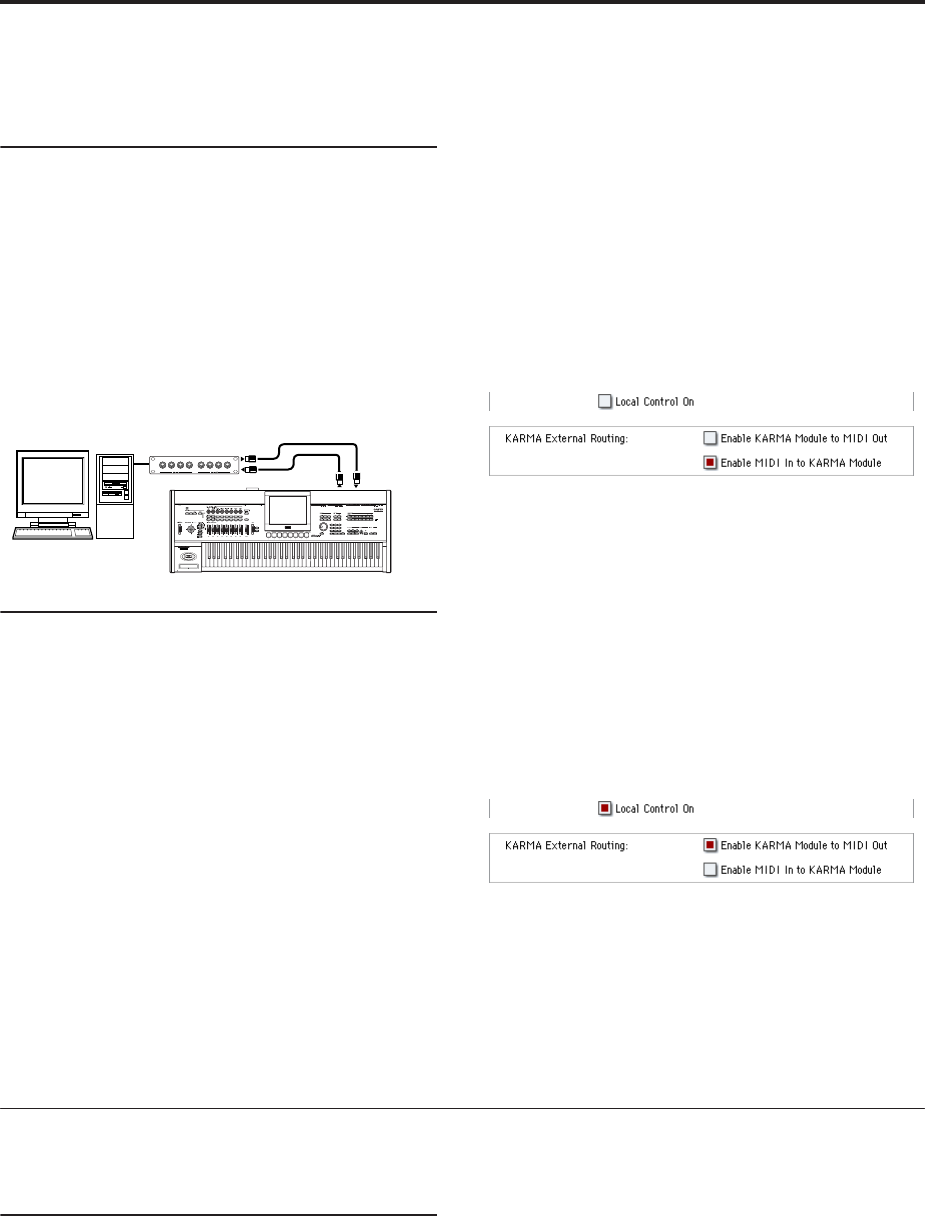
Appendices
1002
Outgoing MIDI data will be handled with settings
equivalent to Key Transpose 0, Velocity Curve 4,
and After Touch Curve 3.
Connecting an external MIDI sequencer or
computer
You can play the OASYS’s keyboard and record your
performance on an external MIDI
sequencer/computer (connected via a MIDI interface),
and then play back the recorded performance to sound
the OASYS’s tone generator (i.e., using the OASYS as
an input keyboard and MIDI tone generator). To do
this, connect the MIDI OUT and MIDI IN connectors of
the OASYS and your external MIDI sequencer/
computer to each other.
Local Control On settings
When connections are made as shown above, turn on
the Echo Back function of the external MIDI sequencer
or computer (so that data received at MIDI IN will be
re-transmitted from MIDI OUT), and turn off the
OASYS’s Local Control setting (so that the OASYS’s
keyboard and tone generator will be internally
disconnected).
When you play the keyboard of the OASYS, the
musical data will be transmitted to the external MIDI
sequencer or computer, and then echoed back to play
the OASYS’s tone generator. In other words, by
turning Local Control OFF, you can prevent notes from
being sounded in duplicate, as would otherwise occur
if a note were sounded by the OASYS’s own keyboard
and again by the data that was echoed-back.
To turn off Local Control, press the “Local Control On”
(Global P1: 1–1a) check box to uncheck it.
When using the OASYS by itself, leave Local Control
turned on. (If this is off when the OASYS is used by
itself, playing the keyboard will not produce sound.)
When using the KARMA function, the Global
KARMA External MIDI Routing settings and the
local control on/off setting will determine how the
function is controlled, as follows. For more
information, see “KARMA External Routing” on
page 654.
Here are the settings to use if you want an external
MIDI sequencer or computer to record only the notes
that trigger the KARMA function, and control the
KARMA function using the notes that are echoed-back
during recording or playback.
When the KARMA function is turned on, playing the
OASYS’ keyboard will not trigger the KARMA
function; the notes you play on the keyboard will only
be transmitted. The KARMA function will operate
only on the notes that are echoed-back and received at
MIDI IN. This prevents the KARMA function from
being applied in duplicate, and ensures that it will
operate correctly.
Note: You can also make these settings by using the
page menu command “Setup KARMA External MIDI
Routing”= Send the output of KARMA to external
device/sequencer. For more information, see “Set Up
KARMA External MIDI Routing” on page 686.
Here are the settings to use if you want the note data
generated by the KARMA function to be transmitted
via MIDI and recorded on your external sequencer or
computer.
Note: You can also make these settings by using the
page menu command “Setup KARMA External MIDI
Routing”= Trigger KARMA generation from external
device/sequencer.
Messages transmitted and received by the OASYS
In the text below, […] indicates hexadecimal notation.
MIDI channels
MIDI messages can be exchanged when the
transmitting and receiving devices are set to the same
MIDI channel. MIDI uses sixteen channels, numbered
1–16. The way in which channels are handled will
differ depending on the mode.
Program mode and Sampling mode
• Transmission/reception is performed on the global
MIDI channel.
The global MIDI channel is the basic channel that
the OASYS uses for MIDI transmission/reception,
and is set by MIDI Channel (Global 1–1a).
Combination mode
• The global MIDI channel is used to transmit/
receive messages for selecting a combination and
turning effects on/off, and to transmit/receive
exclusive data.
• Each timbre will transmit/receive MIDI data on the
MIDI Channel (Combination 2–1a) that is specified
for that timbre.
• The Ch MIDI channel specified for each effect
(Combination 8–7a, 9–2a, 9–3, 9–4, 9–5) is used to
control dynamic modulation of the insert/master/
computer
MIDI IN
OASYS
MIDI interface
MIDI INMIDI OUT
MIDI OUT


















